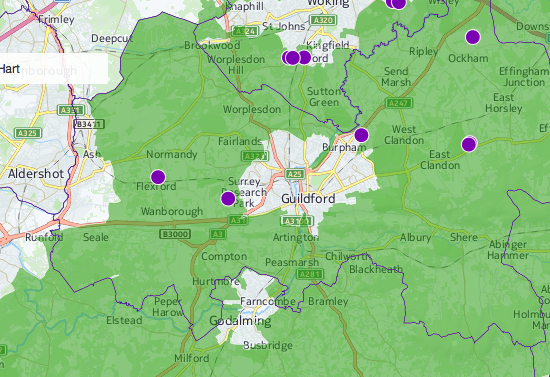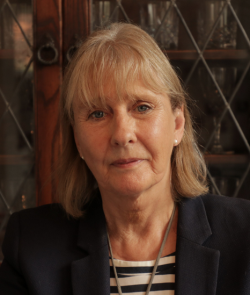 Abraham Lincoln
If given the truth, the people can be depended upon to meet any national crisis...
Abraham Lincoln
If given the truth, the people can be depended upon to meet any national crisis...
 Guildford news...
for Guildford people, brought to you by Guildford reporters - Guildford's own news service
Guildford news...
for Guildford people, brought to you by Guildford reporters - Guildford's own news service
Stronger Green Belt Protection ‘Vital to Climate Change Campaign’
Published on: 4 Jul, 2019
Updated on: 5 Jul, 2019
 Local authorities in London and the Home Counties which have declared a “climate emergency” in their districts, and propose to adopt strategies and action plans to tackle climate change, are being urged to include policies of stronger protection for green spaces in their plans, because these provide vital climate change mitigation.
Local authorities in London and the Home Counties which have declared a “climate emergency” in their districts, and propose to adopt strategies and action plans to tackle climate change, are being urged to include policies of stronger protection for green spaces in their plans, because these provide vital climate change mitigation.
The London Green Belt Council (LGBC), which represents more than 100 environmental and community groups across the region, warns that some local councils are being inconsistent by declaring a “climate emergency” but failing to prevent development on green belt countryside and open spaces which provide vital mitigation for climate change.
Some of these local authorities are even putting forward large swaths of green belt land for housebuilding despite their professed commitment to environmental protection.

Green belt land in Guildford Borough.
LGBC chair Richard Knox-Johnston said: “The green belt is a vital green lung for people in London and the wider South-east. Protecting green spaces makes a hugely important contribution to people’s health and well-being as well as maintaining essential eco-systems and providing wildlife corridors.
“Green spaces help to mitigate climate change because carbon is absorbed by vegetation and held long-term in soils. They also help us adapt to climate change by absorbing rainwater and cooling our towns and cities.
“The more green space we lose, the more we are at risk from flooding and rising temperatures, two of the predicted effects of climate change
“District and borough councils are absolutely right to recognise the seriousness of climate change and to acknowledge the role that local government can play in tackling the climate crisis, but if they do not also pledge to defend the green belt and countryside from development then they are failing in their duty to protect our communities and environment.”

Protestors carrying the Guildford Schools Strike 4 Climate Change Banner in April
The LGBC is calling on all local authorities to state categorically that climate change mitigation requires the protection of green belt countryside and open spaces, and to agree to block developers’ proposals for building on green belt land.
This is especially important, the LGBC points out, at a time when London itself needs to become more resilient to climate emergencies which means it needs to have plenty of green spaces around it.
Mr Knox-Johnston added: “Giving up green belt to development is an easy answer to the housing shortage but actually it does nothing to improve the affordability of housing. All it does is leave communities with less greenspace. In fact, there has never been a greater need to protect the green belt from development.”
The LGBC is working with a wide range of partner organisations to produce a consultation paper setting out “A Vision for the Future of London’s Green Belt”. This emphasises the green belt’s value for health and well-being, biodiversity and environmental sustainability, and its crucial importance to the fight against climate change.

Cllr Diana Jones
Diana Jones, the Green Party borough councillor for Tillingbourne, was asked how she assessed the conflicting priorities of meeting the housing targets as set out in Guildford’s Local Plan, and the need to protect the environment.
She said: “There is no doubt that we need more, mostly affordable houses especially for key workers, young professionals and first time buyers, and also no doubt that building it in the traditional way is going to cause damage to the Environment, both in the long and the short term.
“Government has been putting pressure on councils to take more land out of the green belt, in effect prioritising the need to build houses over protection of the environment. For Guildford this has resulted in the unpopular Local Plan which takes three large swaths out of our green belt in an attempt to meet the 10,000 homes target that the area has been given by the government.
“Whether this actually delivers the affordable housing we need is disputed by the Campaign for Rural England (CPRE) where recent analysis shows that only 22% of the homes planned on land released from the green belt would meet the government’s definition of “affordable”, ie 80% of market value, which to most in the South-east of the country is not affordable at all.
“If what is wanted is quality homes that can be provided quickly and easily with minimum impact on the environment, companies like Zedpods offer to build on existing carparks and hardstanding. Companies like these provide high-performance, low-energy housing delivered in a fraction of the time, and at a fraction of the cost, often on raised platforms that enable the car park to continue to be used as a car park.
“Fulfilling our housing quota does not need to mean building acres of brick and mortar housing estates on green field plots, where everyone needs a car or more per household, and all the pollution and congestion that goes with that.
“It can be far more practical and far more eco-friendly. A serious desire to build enough for the ever-increasing population without destroying our patch means embracing the current technology.
“Of course, the traditional wisdom that you must build on brownfield sites before green, still holds. Build in the town before you consider the green fields. But the council must also look at a masterplan for Guildford Town Centre, an essential for “joined-up” development, but resisted by some councillors and officers.
“Then they must look at the “super-insulated envelope” the triple-glazed windows, the ventilation heat recovery, solar, and photovoltaic roof tiles, power walls, carbon-neutral houses, and practical building for value, rather than building for profit.
“Technology which was considered ‘cutting edge’ 10 years ago is now affordable and available, whereas taking land out of the green belt does little to satisfy the housing need, and does a lot to damage the countryside that we all depend on.”
Cllr Jan Harwood, Lib Dem lead councillor for planning, has been invited to comment.
For further information on the work of the LGBC, go to www.londongreenbeltcouncil.
Responses to Stronger Green Belt Protection ‘Vital to Climate Change Campaign’
Leave a Comment Cancel replyPlease see our comments policy. All comments are moderated and may take time to appear. Full names, or at least initial and surname, must be given.
Recent Articles
- Notice: The Welcoming Committee for Hong Kongers
- Letter: This Shows Why Councils Should Not Dabble in Property Investment
- GBC Dismisses Fears That New Ash Road Bridge Will Cause Traffic ‘Bottleneck’
- Marking Holocaust Memorial Day 2025 at the Surrey History Centre
- Surrey Councils Call on Residents to Recycle All Their Food Waste
- Windfall Grant Allows High Street Redevelopment Project to Proceed
- New Crossing at Burpham
- Young Councillor Quits Tories for Reform
- Surrey Police Crackdown Shows Serious Rise In Drug-Driving
- Letter: Too Many Years Have Been Lost Awaiting This Decision


Recent Comments
- Paul Spooner on Windfall Grant Allows High Street Redevelopment Project to Proceed
- David Roberts on Letter: Shaping Guildford’s Future and Meeting the New Housing Uplift
- Frank Ayling on Cold War Fighter Jet Collision Over Guildford
- Simon Vine on Birdwatcher’s Diary No.318 Some Pre-Christmas Rambles
- RWL Davies on County Council Elections ‘Must Go Ahead’ Say Surrey Council Leaders
- S Callanan on Letter: The National Trust Should Be Embarrassed About How Long the Weir Repair Is Taking
Search in Site
Media Gallery
Dragon Interview: Local Artist Leaves Her Mark At One of England’s Most Historic Buildings
January 21, 2023 / No Comment / Read MoreDragon Interview: Lib Dem Planning Chair: ‘Current Policy Doesn’t Work for Local People’
January 19, 2023 / No Comment / Read MoreA3 Tunnel in Guildford ‘Necessary’ for New Homes, Says Guildford’s MP
January 10, 2023 / No Comment / Read More‘Madness’ for London Road Scheme to Go Ahead Against ‘Huge Opposition’, Says SCC Leader
January 6, 2023 / No Comment / Read MoreCouncillor’s Son Starts Campaign for More Consultation on North Street Plan
December 30, 2022 / No Comment / Read MoreCounty Council Climbs Down Over London Road Works – Further ‘Engagement’ Period Announced
December 14, 2022 / No Comment / Read MoreDragon Interview: GBC Reaction to the Government’s Expected Decision to Relax Housing Targets
December 7, 2022 / No Comment / Read MoreHow Can Our Town Centre Businesses Recover? Watch the Shop Front Debate
May 18, 2020 / No Comment / Read More










Dave Middleton
July 4, 2019 at 2:27 pm
I’m not convinced that infill and brownfield site building is the answer to the housing crisis nationally. All it seems to do is overload existing infrastructure; roads, sewers, water supply, electricity cables, etc.
Yes we need to protect the green belts, but we also need to build housing.
Is it now time for the building of several new, “garden cities”, where the infrastructure can be built and future proofed, with capacity to cope, even if it does mean building on greenfield and farmland sites? Disused and surplus RAF Station sites would be good starting points perhaps for new towns and villages?
Valerie Thompson
July 4, 2019 at 5:44 pm
Hear hear!
But the three large threatened areas of Wisley, Gosden Hill and Blackwell Farm are only a part of the green belt story. GBC is forcing some small villages to increase their housing stock by a third more, all of it on green belt land.
With the possibility of other applications being put in for “windfall” sites, this could increase the village populations, large houses, car pollution, overcrowded schools, car parks, trains and surgeries by a significant amount. Even if these sites include some affordable housing it is not good enough compensation for Guildford Borough being ruined.
No thought has been given to the future well-being of the elderly and children suffering from increased pollution and the lack of facilities and recreation areas. SANGs are sometimes placed in inaccessible areas without using a car to get there, witness the SANG on Long Reach in West Horsley, ostensibly to offset the Berkley Homes development of The Howard of Effingham School site in Effingham some five kilometres away.
Peter Elliott
July 5, 2019 at 11:22 am
Well said, Diana Jones. I was particularly interested to hear about the photovoltaic roof tiles, as conventional solar panels look so unsightly on older houses.
Clearly, if the new council decided to respond to the heightened concern about climate change by following the Office of National Statistics assessment of local housing need and built 6,000 new houses, not the Tory developer’s bonanza of 14,000, there would be no need to build thousands of houses on the green belt and they could do their bit to save that bit of the planet for which they are responsible.
John Perkins
July 6, 2019 at 10:01 am
A glossy and expensive pamphlet dropped through my door inviting me to a “public consultation” on the development of Garlick’s Arch in Send, “an allocation in Guildford’s Local Plan”.
The site is currently green belt fields and ancient woodland. Soon it will be concrete, tarmac and 550 expensive little boxes. GBC has said it’s ok because they don’t intend to cut down the old trees.
Thanks Cllr Spooner.
Ruth Brothwell
July 6, 2019 at 4:51 pm
Thank you, John Perkins, but please note that the old council removed this area from the green belt along with much more. The R4GV group along with GGG and Diana Jones of the Green Party are actively looking into this.
Garlick’s Arch is just the beginning. Let’s attend the consultation on Garlick’s Arch so we are informed about what might be coming to a place near you!
Meanwhile we will continue to ask the questions we need answers to.
Cllr Ruth Brothwell is a R4GV borough councillor for Worplesdon
John Perkins
July 8, 2019 at 6:18 pm
Apologies for not making myself clear: it was a GBC official under the previous council who defended the proposal in that way.
Valerie Thompson
July 6, 2019 at 5:28 pm
Thanks Caroline Reeves, our new GBC Leader, who supported the Tories in their destructive Local Plan. I understand she is also proposing to contest the three Judicial Reviews that have been submitted.
Lisa Wright
July 7, 2019 at 9:17 pm
I would dispute that Guildford has been told by the government to build 10,000 homes. Firstly, GBC has decided to build 14,000 homes, a target that GBC councillors imposed, specifically Conservative councillors. The 10,000 target was artificially manipulated upwards to allow for ‘growth’.
Growth is not required in Guildford, or Surrey, or possibly most of the South East. Growth and investment, particularly new employment, is desperately needed in dozens of towns and cities around the country where unemployment rates are much higher.
If the majority of our workers didn’t have to commute to London every day we could make a real impact on our emissions and perhaps spend a bit more time with our families too.